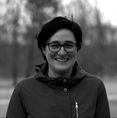|
|
|||
 Your first feature FREM (international premiere Berlinale 2020) connected artificial intelligence and the climate crisis against the backdrop of the desolate King George Island, off the coast of Antarctica. White on White (the Best World Documentary Film Ji.hlava IDFF 2020) is the video diary you kept while filming FREM. To what extent does Notes from Eremocene connect to your previous films?
Your first feature FREM (international premiere Berlinale 2020) connected artificial intelligence and the climate crisis against the backdrop of the desolate King George Island, off the coast of Antarctica. White on White (the Best World Documentary Film Ji.hlava IDFF 2020) is the video diary you kept while filming FREM. To what extent does Notes from Eremocene connect to your previous films?
From the chronological point of view Notes from Eremocene is a final film of an intuitive trilogy dealing with the same motives, narratives, issues: artificial intelligence, a dystopian future of humankind, analogue versus digital, nature versus civilization, and climate change. Although in terms of content and form it is actually a prologue to FREM, because it exposes the world that already takes place in FREM. With White on White, Notes from Eremocene shares a personal, diary style input, which refers to the “Private Golden Record”, a motive, also fragmentarily present in FREM, but this time the setup is more contemporary and political. Using quantum physics vocabulary, we could say the three films are entangled, they “communicate” with each other, but at the same time, they stand alone in different corners of the same universe, formally quite different from each other. For me, creating these three films was a long and complicated process, and actually at some point it was hard for me to determine when or where one film ends and the other one begins.
The past, the present and the future all seem connected in this film. Can you elaborate how each of these perspectives on time play a part in the film?
Time is a difficult category. In the physical world it goes one direction because everything obeys the second law of thermodynamics (at least that is the actual state of knowledge). The virtual/digital reality is timeless. The past, present and future exist together as layers of the same elementary grid. You can dive into it at any random coordinates and as you move through the hyper object of all the information, you create your own pathway – your own time and space pattern.
You have combined 8 mm and 16 mm diary images with 3D scenes shot with special Lidar technology. Why did you choose to combine these different formats?
I wanted to create the tension between the two layers of the planetary grid – one based on carbon, the other one on silicone. These formats felt right to express such tension. Also, I really like shooting on film, paradoxically it makes me feel much more free, focused, and joyful while shooting. Lidar was quite a new technology when I started to experiment with it (no iPhone had it yet), and I like to discover new things.
Related AIC articles:
Forum: Notes from Eremocene
published: 08.02.2023
updated: 08.02.2023




